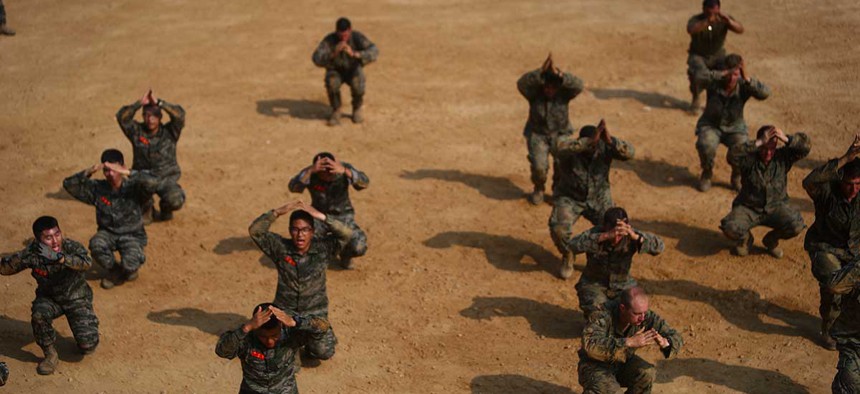The Upcoming U.S.-South Korea Military Drills Occur Every Year—But Not Amid Tension Like This
The exercises are preceded by threats and developments unique to 2017.
The upcoming military exercises by the US and South Korea occur every year. What doesn’t: a fiery war of words between North Korea and the US president just ahead of the drills.
Pyongyang has long viewed the “Ulchi-Freedom Guardian” exercises, slated for Aug. 21-31 this year, as preparation for war, not merely for the defense of South Korea as billed. But this year the drills are being preceded by a number of threats and developments unique to 2017, including North Korea testing an intercontinental ballistic missile that can reach the continental US.
As Quartz has written, with tensions high on the Korean Peninsula, a small military incident could rapidly escalate into a full-blown war. Should Pyongyang feel that a “decapitation strike” is imminent, it might choose to move first, Euan Graham, a security analyst with the Lowy Institute for International Policy in Sydney, has said.
Late last week Donald Trump tweeted that “military solutions are now fully in place, locked and loaded, should North Korea act unwisely.” It’s unclear to what degree the upcoming drills factored into his thinking, but they’ll certainly be on minds in Pyongyang, along with words like “now fully in place.”
Those words came after KCNA, the official news agency of North Korea, derided an earlier Trump statement threatening “fire and fury” as a “load of nonsense” from a “a guy bereft of reason.” Citing a military general, it said North Korea would shortly develop a plan for launching four missiles over Japan and into the waters near Guam, where the US has a large military presence. It would then be up to leader Kim Jong-un as to when to fire the missiles—during the exercises, conceivably.
Earlier last week Donald Trump told reporters, “North Korea best not make any more threats to the United States. They will be met with fire and fury like the world has never seen.”
In response, Bill Richardson, a former US ambassador to the UN, told CNBC’s Squawk on the Street, “You never know how the North Koreans are going react… especially Kim Jong-un, who’s afraid of his own shadow, who is concerned about… being toppled, regime change.”
Meanwhile analysts and historians told the New York Times (paywall) that such a threat from a US president had little precedent in modern history.
The upcoming military exercises by the US and South Korea occur every year. What doesn’t: a fiery war of words between North Korea and the US president just ahead of the drills.
Pyongyang has long viewed the “Ulchi-Freedom Guardian” exercises, slated for Aug. 21-31 this year, as preparation for war, not merely for the defense of South Korea as billed. But this year the drills are being preceded by a number of threats and developments unique to 2017, including North Korea testing an intercontinental ballistic missile that can reach the continental US.
As Quartz has written, with tensions high on the Korean Peninsula, a small military incident could rapidly escalate into a full-blown war. Should Pyongyang feel that a “decapitation strike” is imminent, it might choose to move first, Euan Graham, a security analyst with the Lowy Institute for International Policy in Sydney, has said.
Late last week Donald Trump tweeted that “military solutions are now fully in place, locked and loaded, should North Korea act unwisely.” It’s unclear to what degree the upcoming drills factored into his thinking, but they’ll certainly be on minds in Pyongyang, along with words like “now fully in place.”
Those words came after KCNA, the official news agency of North Korea, derided an earlier Trump statement threatening “fire and fury” as a “load of nonsense” from a “a guy bereft of reason.” Citing a military general, it said North Korea would shortly develop a plan for launching four missiles over Japan and into the waters near Guam, where the US has a large military presence. It would then be up to leader Kim Jong-un as to when to fire the missiles—during the exercises, conceivably.
Earlier last week Donald Trump told reporters, “North Korea best not make any more threats to the United States. They will be met with fire and fury like the world has never seen.”
In response, Bill Richardson, a former US ambassador to the UN, told CNBC’s Squawk on the Street, “You never know how the North Koreans are going react… especially Kim Jong-un, who’s afraid of his own shadow, who is concerned about… being toppled, regime change.”
Meanwhile analysts and historians told the New York Times (paywall) that such a threat from a US president had little precedent in modern history.





